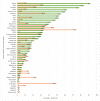Organic Medicinal and Aromatic Plants: Consumption Profile of a Portuguese Consumer Sample
- PMID: 38002202
- PMCID: PMC10670743
- DOI: 10.3390/foods12224145
Organic Medicinal and Aromatic Plants: Consumption Profile of a Portuguese Consumer Sample
Abstract
The production and consumption of organic products have been increasing in Portugal, as well as in the European Union as a whole. The main objective of this work is to understand the consumption habits of organic medicinal and aromatic plants (OMAPs) among Portuguese adults. An online questionnaire was distributed using social networks, resulting in the collection and statistical analysis of 300 responses. Of the participants who reported consuming OMAPs, 44.3% showed a daily consumption pattern. The most frequently mentioned OMAPs for fresh consumption were parsley (Petrosselinum crispum L., 92%), garlic (Allium sativum L., 84.1%), and coriander (Coriandrum sativum L., 78.1%). The most commonly mentioned OMAP for consumption as dried plants were oregano (Origanum vulgare L., 74.6%), lemon balm (Melissa officinalis L., 49.2%), and lemon verbena (Aloysia citrodora L., 46.8%). The main reasons cited for using OMAPs were their benefits to health (58.7% of participants), benefits to the environment (33.2%), and reduced salt consumption (29.5%). Among these, the main health benefits mentioned included anti-inflammatory properties (45.0%), prevention of cardiovascular diseases (41.6%), and prevention of high cholesterol (39.9%). Furthermore, 82.5% of respondents considered themselves sufficiently, well, or excellently informed about the nutritional properties of OMAPs. This research initiates a discussion about whether profiling OMAP consumption habits can serve as a valuable tool for promoting organic farming in Portugal, increasing OMAP production and consumption, and strengthening the connection between these products and potential positive human health effects.
Keywords: consumption habits; health; medicinal and aromatic plants; organic farming; questionnaire.
Conflict of interest statement
The authors declare no conflict of interest.
Figures
Similar articles
-
Target specific post-harvest treatment by gamma radiation for the microbial safety of dried Melissa officinalis and Aloysia citrodora.Appl Radiat Isot. 2021 Feb;168:109391. doi: 10.1016/j.apradiso.2020.109391. Epub 2020 Oct 17. Appl Radiat Isot. 2021. PMID: 33097381
-
Antioxidant capacity and total phenolic contents of oregano (Origanum vulgare), lavender (Lavandula angustifolia) and lemon balm (Melissa officinalis) from Romania.Nat Prod Res. 2011 Oct;25(17):1657-61. doi: 10.1080/14786419.2010.521502. Epub 2011 Jun 27. Nat Prod Res. 2011. PMID: 21707233
-
Chemical Variability of the Essential Oils from Two Portuguese Apiaceae: Coriandrum sativum L. and Foeniculum vulgare Mill.Plants (Basel). 2023 Jul 24;12(14):2749. doi: 10.3390/plants12142749. Plants (Basel). 2023. PMID: 37514362 Free PMC article.
-
Native Iranian Medicinal Plants with Anti-Vaginal Infection Properties: A Systematic Review.Infect Disord Drug Targets. 2022;22(6):e010522204326. doi: 10.2174/1871526522666220501171551. Infect Disord Drug Targets. 2022. PMID: 35490427
-
Aloysia citrodora Paláu (Lemon verbena): A review of phytochemistry and pharmacology.J Ethnopharmacol. 2018 Aug 10;222:34-51. doi: 10.1016/j.jep.2018.04.021. Epub 2018 Apr 23. J Ethnopharmacol. 2018. PMID: 29698776 Review.
References
-
- Carvalho A.M., Ramos M.T. Plantas Aromáticas e Medicinais: Usos e Saberes de Sempre, Perspectivas Actuais e de Futuro. Assoc. Port. Hortic. 2009;96:37–42.
-
- Lubbe A., Verpoorte R. Cultivation of Medicinal and Aromatic Plants for Specialty Industrial Materials. Ind. Crops Prod. 2011;34:785–801. doi: 10.1016/j.indcrop.2011.01.019. - DOI
-
- Barata A.M., Rocha F., Lopes V., Bettencourt E., Figueiredo A.C., Barata A.M. Medicinal and Aromatic Plants—Portugal. [(accessed on 9 March 2023)]. Available online: http://www.eolss.net.
-
- Barata A.M.L.V. Estudo Do Setor Das Plantas Aromáticas, Medicinais e Condimentares em Portugal. INIAV; Lisbon, Portugal: 2021. pp. 80–85.
-
- Şenkal B.C. The Role of Secondary Metabolites Obtained from Medicinal and Aromatic Plants in Our Lives. ISPEC J. Agric. Sci. 2020;4:1071–1079.
LinkOut - more resources
Full Text Sources




